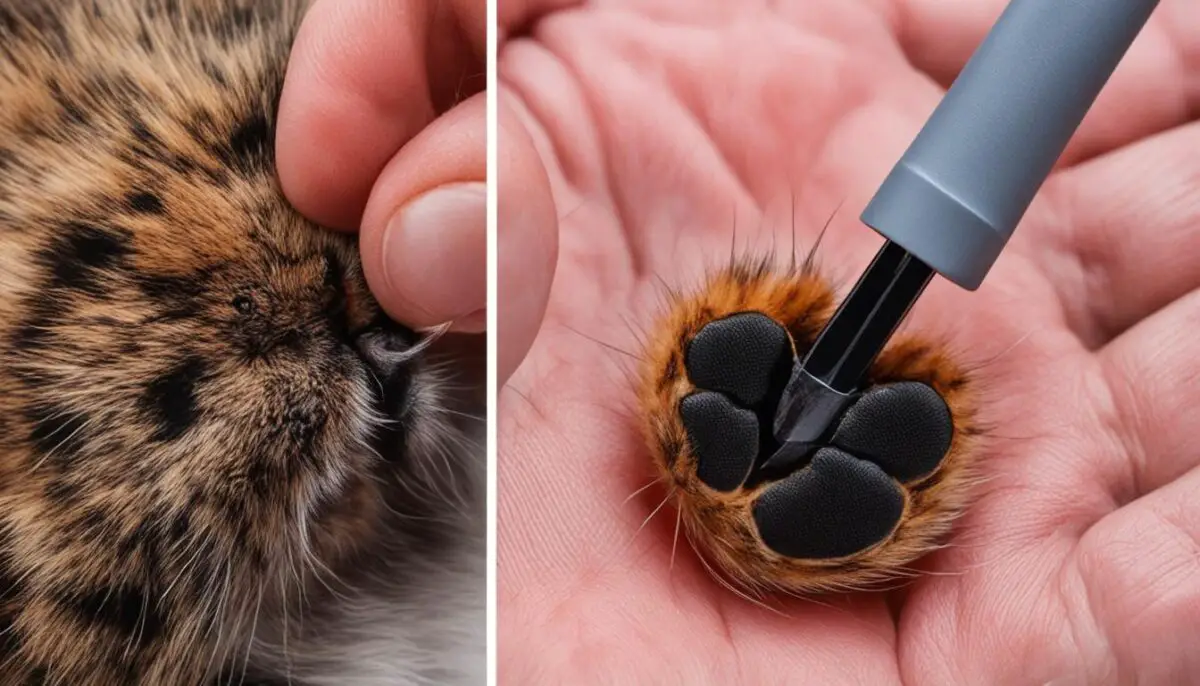Tick-borne diseases are a growing concern for pet owners. One such disease is Lyme disease, caused by the bacterial spirochete Borrelia burgdorferi. While often associated with humans and dogs, cats can also be affected.
Cats can contract Lyme disease if bitten by infected ticks. These ticks acquire the bacteria while feeding on wildlife like deer, rabbits, and rodents. While cats may not show obvious signs of the disease, it’s important for pet owners to be aware of the symptoms.
The most common symptoms of Lyme disease in cats include lameness, fatigue, loss of appetite, and fever. In severe cases, cats may experience kidney problems, vomiting, weight loss, lethargy, and edema.
Diagnosing Lyme disease in cats involves considering their history, signs of disease, and blood tests. Treatment typically involves the use of antibiotics, with doxycycline being the preferred choice.
Key Takeaways:
- Lyme disease is a tick-borne disease caused by Borrelia burgdorferi in cats.
- Cats can show symptoms such as lameness, fatigue, loss of appetite, and fever.
- Diagnosis is done through history, signs of disease, and blood tests.
- Treatment involves the use of antibiotics, with doxycycline as the gold standard.
- Prevention through tick control is crucial in avoiding Lyme disease in cats.
Causes of Lyme Disease in Cats
Lyme disease in cats is caused by the bacteria Borrelia burgdorferi, which is transmitted through the bite of an infected tick. Ticks become carriers of the bacteria after feeding on wildlife, such as deer, rabbits, and rodents, that are already infected. When a tick bites a cat, the bacteria can enter the cat’s bloodstream, leading to the development of Lyme disease.
Ticks must be attached to the cat for 24 to 48 hours before the transmission of the bacteria occurs. Therefore, early detection and removal of ticks is crucial in preventing Lyme disease in cats.
Tick preventatives play a vital role in the prevention of Lyme disease in cats. These preventive treatments help to repel and kill ticks, reducing the risk of tick bites and the transmission of Lyme disease. It is important to use tick preventatives consistently and according to the instructions provided by your veterinarian.
Once a tick carrying Borrelia burgdorferi bites a cat, the bacteria quickly replicates on the skin and then migrates through the cat’s tissues, causing systemic symptoms of Lyme disease.

Image: A visual representation of a tick, the vector for Lyme disease in cats.
Symptoms of Lyme Disease in Cats
Cats rarely show signs of Lyme disease, but when present, the most common symptoms include lameness, fatigue, loss of appetite, and fever. More severe cases can lead to vomiting, weight loss, severe lethargy, edema, and damage to the nervous system and heart. The presentation of symptoms in cats is different from humans, with the absence of the characteristic “bull’s eye” rash.
If you notice any of the following symptoms in your cat, it’s important to consult a veterinarian for proper evaluation and diagnosis:
- Lameness or difficulty walking
- Excessive fatigue or weakness
- Loss of appetite or decreased food intake
- High body temperature or fever
- Vomiting
- Weight loss
- Severe lethargy
- Swollen limbs or body parts (edema)
- Neurological issues such as difficulty in coordination or seizures
- Cardiac abnormalities
It’s important to note that these symptoms may also be indicative of other medical conditions, so a proper diagnosis is necessary to identify the underlying cause. The absence of the characteristic “bull’s eye” rash in cats makes it more challenging to diagnose Lyme disease based on visual symptoms alone.
Next, let’s explore the diagnostic methods used to confirm Lyme disease in cats.

Symptoms of Lyme Disease in Cats
| Symptom | Description |
|---|---|
| Lameness | Difficulty walking; limping |
| Fatigue | Excessive tiredness; lack of energy |
| Loss of appetite | Reduced interest in eating or decreased food intake |
| Fever | Elevated body temperature |
| Vomiting | Forceful expulsion of stomach contents |
| Weight loss | Unintended decrease in body weight |
| Severe lethargy | Extreme tiredness; lack of activity or responsiveness |
| Edema | Swelling of limbs or body parts |
| Neurological issues | Abnormalities in coordination or seizures |
| Cardiac abnormalities | Anomalies in the heart’s structure or function |
Diagnosis of Lyme Disease in Cats
Diagnosing Lyme disease in cats involves a combination of evaluating the cat’s history, identifying signs of disease, and conducting laboratory tests. A thorough understanding of the cat’s exposure to ticks and the onset of symptoms is crucial for an accurate diagnosis.
One common diagnostic method is the use of blood tests to confirm the presence of Lyme disease antibodies. These tests detect specific proteins produced by the cat’s immune system in response to the infection. However, it’s important to note that cats exposed to Lyme disease may not test positive for several weeks after a tick bite.
In some cases, additional diagnostic tests such as blood work and radiographs may be performed to rule out other diseases that may have similar symptoms. Radiographs can help identify any signs of arthritis or joint abnormalities, which can be associated with Lyme disease in cats.

“Proper diagnosis is crucial to ensure appropriate treatment and management for cats with Lyme disease. Utilizing a combination of history, signs of disease, and laboratory tests can lead to a more accurate diagnosis and effective treatment plan.”
Treatment of Lyme Disease in Cats
The main treatment for lyme disease in cats is the antibiotic doxycycline. However, not all cats can tolerate this antibiotic, so alternatives may be used.
Antibiotics are typically prescribed for a month, but additional courses may be necessary to prevent flare-ups. It is important to administer the full course of antibiotics as directed by the veterinarian to ensure complete eradication of the bacteria causing Lyme disease.
In addition to antibiotics, non-steroidal anti-inflammatories and other pain relief medications may be used to manage acute pain and discomfort associated with Lyme disease symptoms.
For severe cases of Lyme disease in cats, hospitalization and additional supportive care may be required to monitor and stabilize the cat’s condition.

“Early treatment with appropriate antibiotics is key to a successful outcome for cats with lyme disease.” – Dr. Smith, Veterinarian
Recovery and Management of Lyme Disease in Cats
After starting antibiotic treatment, most cats with Lyme disease experience an improvement in their condition within a day or two. However, it is crucial to complete the full course of antibiotics prescribed by the veterinarian to ensure a complete recovery. While antibiotics can help control the infection, it is important to note that Lyme disease may never be fully cleared from the cat’s body.
In some cases, relapses may occur, requiring additional courses of antibiotics to manage the symptoms effectively. Monitoring the cat’s health and seeking veterinary care promptly can help identify and address any relapses or complications that may arise.
Complications associated with Lyme disease in cats include:
- Arthritis: Joint inflammation and pain can occur, leading to lameness and impaired mobility.
- Kidney damage: In severe cases, Lyme disease can cause long-term damage to the kidneys, impacting their normal function.
Proactive management and ongoing veterinary care are essential for cats affected by Lyme disease. Regular check-ups and monitoring can help detect any signs of relapse or complications, allowing for timely intervention and appropriate treatment adjustments.
Additionally, providing a supportive and comfortable environment for the affected cat is crucial for its overall well-being. Ensuring a balanced diet, plenty of fresh water, and a stress-free environment can aid in the recovery process.

The infographic below summarizes the recovery and management strategies for cats with Lyme disease:
| Recovery and Management Strategies for Lyme Disease in Cats |
|---|
|
By adopting these recovery and management strategies, cat owners can give their feline companions the best chance at a successful recovery from Lyme disease.
Prevention of Lyme Disease in Cats
Preventing Lyme disease in cats is essential for their health and well-being. By taking proactive measures to control ticks, you can greatly reduce the risk of your furry friend contracting this disease.
Tick Preventatives: Using tick preventatives regularly is key to protecting your cat from Lyme disease. These products are specifically designed to repel ticks and prevent them from attaching to your cat’s body. Make sure to choose a tick preventative that is safe and effective for cats, and follow the instructions provided by your veterinarian.
Tick Removal: If you happen to find a tick on your cat, it is important to remove it promptly. Use tweezers or a tick removal tool to grasp the tick close to the skin and gently pull it out. Be sure to remove the entire tick, including its mouthparts. Dispose of the tick properly, and clean the area with an antiseptic.
No Vaccine: Unfortunately, there is currently no vaccine available for Lyme disease in cats. Therefore, prevention through tick control is crucial in keeping your cat safe and healthy.
Tick-Borne Diseases in Humans: It’s important to remember that tick-borne diseases can also affect humans. When handling ticks or spending time in tick-infested areas, take precautions to protect yourself. Wear protective clothing, use insect repellent, and perform thorough tick checks on yourself and your pets after outdoor activities.
By following these preventive measures, you can significantly reduce the risk of Lyme disease in your beloved feline companion.
| Preventive Measures | Description |
|---|---|
| Use Tick Preventatives | Regularly apply tick preventatives to repel ticks and prevent them from attaching to your cat’s body. |
| Tick Removal | Promptly remove ticks using tweezers or a tick removal tool, ensuring that the entire tick is removed. |
| No Vaccine | Currently, there is no available vaccine for Lyme disease in cats, so prevention through tick control is crucial. |
| Protect Yourself | Take precautions when handling ticks or spending time in tick-infested areas, as tick-borne diseases can also affect humans. |
By implementing these preventive measures and staying vigilant, you can help keep your cat safe from Lyme disease and enjoy a happy and healthy life together.
Conclusion
Lyme disease in cats is a relatively rare but serious condition that can lead to significant health issues if left untreated. Recognizing the symptoms and seeking veterinary care promptly is essential for the well-being of our feline friends. The most common symptoms of cat lyme disease include lameness, fatigue, loss of appetite, and fever, but severe cases can lead to kidney problems, vomiting, weight loss, lethargy, and edema.
To ensure the prevention of Lyme disease in cats, it is crucial to focus on tick control. Using tick preventatives regularly on all cats and promptly removing any ticks found are effective preventive measures. Unfortunately, there is no vaccine available specifically for Lyme disease in cats. Therefore, tick prevention remains the best strategy for keeping our cats safe.
Remember, Lyme disease in cats may be relatively rare, but it is important to stay vigilant and take action if any symptoms are observed. By understanding the risks, recognizing the symptoms, and prioritizing prevention, we can help protect our feline companions from the potential dangers of Lyme disease.
FAQ
What are the symptoms of Lyme disease in cats?
The most common symptoms of Lyme disease in cats include lameness, fatigue, loss of appetite, and fever. Severe cases can lead to kidney problems, vomiting, weight loss, lethargy, and edema.
How is Lyme disease in cats diagnosed?
Diagnosis of Lyme disease in cats is based on history, signs of disease, and laboratory tests. Blood tests are commonly used to confirm the presence of Lyme disease antibodies. Cats exposed to Lyme disease may not test positive for several weeks after a tick bite.
What is the treatment for Lyme disease in cats?
The main treatment for Lyme disease in cats is the antibiotic doxycycline. However, not all cats can tolerate this antibiotic, so alternatives may be used. Antibiotics are typically prescribed for a month, but additional courses may be necessary to prevent flare-ups.
How long does it take for cats to recover from Lyme disease?
Most cats start feeling better within a day or two after starting antibiotic treatment. However, it is important to complete the full course of antibiotics to ensure complete recovery. Lyme disease may never be fully cleared from the body, so there is a possibility of relapses which may require additional courses of antibiotics.
How can Lyme disease in cats be prevented?
Tick prevention is the best way to avoid Lyme disease in cats. Tick preventatives should be used regularly on all cats, and ticks should be promptly removed if found. There is no vaccine for Lyme disease in cats, so prevention through tick control is crucial.

